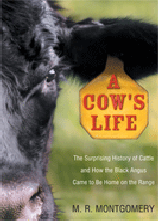|
|
|
|
(continued from previous page)
It may seem ironic that the Aberdeen-Angus breed, prized for its perceived superiority on the plate, should have originated in Scotland, which is hardly noted for its cuisine, although haggis, made from sheep offal and oatmeal, is actually rather good on a winter night, preferably on Robbie Burns's birthday, and with a single malt whiskey to clear the palate. If ever a country
bred up a cow for culinary qualities, France or Italy would seem much likelier candidates. However, in the early nineteenth century when Scottish farmers were refining the Aberdeen-Angus breed, their rivers teemed with salmon and sea trout, the coast bore everything from scallops and cockles to lobsters and langoustines, and offshore dwelt haddock just waiting for a touch of smoke to become the best of all possible breakfast entrees, finnan haddie. Everything was (and in some small Scottish towns still is) all of the finest quality. From the days when their only tableware was a dirk, the Scots have been connoisseurs of great raw materials.
Aberdeen-Angus were not the only cattle raised in Scotland, or even the most common or esteemed. But matters of sapidity and succulence aside, the Aberdeen-Angus cow and her kin have a very remarkable trait--they are adaptable to almost any climate and any style of rearing. For more than fifteen hundred years that are known of, the Scots drove their cattle south to be fattened and sold. In the eighteenth century the Scots began to feed their cattle to fatness and sell them finished, ready for the market. For a number of reasons, to be detailed later, the Scotch farmers kept their cattle indoors during the country's long and wet and dark winters, and no cows could be more content in confinement than the Aberdeens and Anguses. Less than one hundred years later, in a remarkable about-face, the cow that would thrive in confinement became the greatest range cow of all time in the vast North American West, hardy enough to weather the severest cold and wind of winter and the oppressive and humid heat of a High Plains summer.
Through all these changes in lifestyle and migrations to the most boreal and topical climates that European cattle can survive, the Aberdeen-Angus kept their true nature. If handled early and often, they are calm and obedient. If left to themselves, they become self-reliant and, as far as human interactions are concerned, nonsocial. But never antisocial. A free-ranging Aberdeen-Angus wants nothing to do with a visitor, but neither will it viciously attack a human being for no reason. Compared to many breeds, the Aberdeen-Angus retain some qualities one associates with human behaviors and attitudes rather than with those of dumb beasts. Aberdeen-Angus can be variously egotistical, self-actuated, resilient, mothering, sociable (with one another), curious, obstinate, amenable, and even insouciant.
The breed underwent some minor changes in the twentieth century, and most of them, but not all, were improvements. Still, the Aberdeen-Angus has retained all of its great qualities. A time-traveler coming from the Spreyside a thousand years ago would recognize these cattle in the field and on the plate. Its continued success as a domesticated animal seems as assured as anything whose future is reliant upon human beings.
Among the thousands of ranchers and farmers (to use the North American and British words for the same occupation) who perpetuate the Aberdeen-Angus breed around the world, I am proud to be related somewhat distantly to the Felton family of Montana, who raise Aberdeen-Angus. They are not famous breeders and don't want to be. The line between fame and mere notoriety is thin, and the Felton Angus Ranch of Big Timber and Brandenburg, Montana, comes down hard on the side of raising productive, well-behaved (for cows), and self-reliant range cattle--honest, middle-class animals. It is men and women like my cousin Margaret Felton, her husband Raymond, and their son Richard who keep the old Scots values in their herds, a practice fortunately found scattered far and wide across the prairies of the United States and Canada.
Chapter One
The Mother of All Cows
Until approximately ten thousand years ago, there was no such thing as a cow. This is not very long ago by evolutionary standards of time, more often measured in units starting at fifty thousand or one hundred thousand years and riot infrequently in the millions of years. Within a few thousand years from the birth of the very first cattle, there were cows scattered across the face of the Old World, from Ireland on the west to China on the east. "Scattered" is not a figure of speech. There were and are great gaps in the map of cattle country--inhospitable deserts, Arctic wastes, and tropics with decimating diseases. It is an amazing story, but it is not an evolutionary event in the ordinary sense of that word, for mankind actually invented the cow anew.
Evolutionary biologists agree that all domestic cattle are descended from a common ancestor--one race or another of the aurochs, the primordial ox. That now-extinct beast has the scientific name of "Bos primigenius" (or first cow). All of the humpless cattle in the Western world are of the recent species "Bos taurus." There are slightly different cattle, humped cattle, that may be descended from another kind of aurochs, and those take the name "Bos indicus" because the classic humped cattle come from the Indian subcontinent.
(continued on next page)
If you’d like to read other book excerpts delivered each day in your email, visit www.DearReader.com.
|
|
|
|
A Cow's Life
by M. R. Montgomery
Buy online:
$16.76
Copyright © 2004
by M. R. Montgomery
Published by
Walker & Company
|
About The Author

M. R. Montgomery is the author of several books, including Jefferson and the Gun-Men, Many Rivers to Cross, and The Way of the Trout, and a former writer for the Boston Globe. A native of Montana, he has spent countless hours visiting and pitching in with chores on his cousin’s Felton Angus Ranch in Big Timber and Brandenburg, Montana. Montgomery lives in Lincoln, Massachusetts.
|
|
|
|

